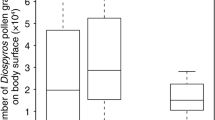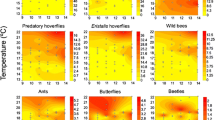Abstract
Many greenhouse crops depend on bees for pollination. Global declines of honeybee populations, and their limited efficiency in pollinating some greenhouse food-plants, motivate the search for additional pollinators. We evaluated the carpenter bee X. pubescens, a local species to Israel, as a pollinator of greenhouse-grown honey dew melons, in comparison to honeybees. We recorded the bees’ daily and seasonal activity patterns in relation to floral nectar levels, frequencies and durations of flower visits, and fruit quantity and quality. The bees’ daily foraging schedule on melon did not correlate with nectar yield and nectar production patterns by the flowers. Visit durations per flower were shorter for X. pubescens than for honeybees. Pollination by both bees resulted in similar fruit mass and seed numbers, but X. pubescens pollination increased fruit set threefold as compared to honeybee pollination. We conclude that X. pubescens can effectively pollinate melons in enclosures.
Zusammenfassung
Viele Nutzpflanzen sind von Bienen als Bestäubern abhängig, besonders in Gewächshäusern. Die Populationen von Honigbienen haben über die vergangenen Jahrzehnte durch den Verlust von Habitaten, Krankheiten, Bekämpfungsmittel und andere Einwirkungen abgenommen. Als Folge leiden viele landwirtschaftliche Pflanzen wegen unzureichender Bestäubung unter verminderter Menge oder Qualität des Ertrags. Die begrenzte Bestäubungsleistung von Honigbienen bei vielen Gewächshauspflanzen ist ein zusätzlicher Anstoß, weitere potentielle Bestäuber zu untersuchen. Die in Israel heimische Holzbiene Xylocopa pubescens (L.) stellt einen möglichen Kandidaten für die Einführung als landwirtschaftlicher Bestäuber dar. Unsere Untersuchung zielte darauf ab, das Bestäubungspotential von X. pubescens mit dem Standardbestäuber Honigbiene zu vergleichen. Im Gewächshaus angebaute Honigmelonen wurden von März bis Dezember 2005 als Modellpflanzen untersucht. Für jeden der Bestäuber untersuchten wir (a) die täglichen und saisonalen Aktivitätsmuster der Bienen im Hinblick auf den Nektarertrag der Melonenblüten (b), die Häufigkeit und Dauer von Blütenbesuchen und (c) die Anzahl, Masse und Samenanzahlen der reifenden Früchte. Sowohl X. pubescens als auch A. mellifera waren in allen Jahreszeiten zumeist in den Morgenstunden aktiv. Die zeitliche Verteilung der Besuche korrelierte bei beiden Bestäuberarten zu allen Jahreszeiten nicht mit dem zeitlichen Verteilungsmuster des Nektarertrages der Blüten, was darauf hinweist, dass das Aktivitätsmuster der Bienen nicht von der Verfügbarkeit ihrer Nahrung beeinflusst wurde. X. pubescens brachte auf jeder Blüte eine kürzere Zeit zu als A. mellifera. Es gab keinen signifikanten Unterschied in der Masse der Melonen oder der Anzahl von enthaltenen Samen zwischen von A. mellifera und X. pubescens bestäubten Blüten. Der Fruchtansatz war demgegenüber bei von X. pubescens bestäubten Blüten dreimal so hoch wie bei von A. mellifera bestäubten Blüten. Dieser hochsignifikante Unterschied weist darauf hin, dass X. pubescens für Melonen in Zelten oder Gewächshäusern einen effizienten Bestäubungsdienst erbringen können. Unsere Daten stellen zum ersten Mal eine quantitative und vergleichende Erfassung der Bestäubungseffizienz von X. pubescens in einem landwirtschaftlichen System dar und tragen weiterhin zu der steigenden Anzahl von Belegen für die Nutzbarkeit lokaler Bienen zur Bestäubung von Gewächshausnutzpflanzen bei.
Similar content being viewed by others
References
Allen-Wardell G., Bernhardt P., Bitner R., Burquez A., Buchmann S., Cane J., Cox A.P., Dalton V., Feinsinger P., Ingram M., Inouye D., Jones C.E., Kennedy K., Kevan P., Koopowitz H., Medellin R., Medellin-Morales S., Nabhan G.P., Pavlik B., Tepedino V., Torchio P., Walker S. (1998) The potential consequences of pollinator declines on the conservation of biodiversity and stability of food crop yields, Conserv. Biol. 12, 8–17.
Ben Mordechai Y., Cohen R., Gerling D., Moscovitz E. (1978) The biology of Xylocopa pubescens (Spinola) (Hymenoptera: Anthophoridae) in Israel, Isr. J. Entomol. 12, 107–121.
Bloch G., Robinson G.E. (2001) Reversal of honey behavioral rhythms, Nature 410, 1048.
Castellanos M.C., Wilson P., Thomas J.D. (2003) Pollen transfer by hummingbirds and bumblebees and the divergence of pollination models in penstemon, Evolution 57, 2742–2752.
Cauich O., Quezada-Euàn J.J., Macias-Macias J.O., Reyes-Oregel V., Medina-Peralta S., Parra-Tabla V. (2004) Behavior and pollination efficiency of Nanotrigona perilampoides (Hymenoptera: Meliponini) of greenhouse tomatoes (Lycopersicon esculentum) in subtropical Mexico, J. Econ. Entomol. 97, 475–481.
Corbet S.A., Fussell M., Ake R., Fraser A., Gunson C., Savage A., Smith K. (1993) Temperature and the pollinating activity of social bees, Ecol. Entomol. 18, 17–30.
Cunningham S.A., FitzGibbon F., Heard T.A. (2002) The future of pollinators for Australian agriculture, Austr. J. Agr. Res. 53, 893–900.
Del Sarto M.C.L., Peruquetti R.C., Campos L.A.O. (2005) Evaluation of the neotripical stingless bee Melipona quadrifasciata (Hymenoptera: Apidae) as pollinator of greenhouse tomatoes, J. Econ. Entomol. 98, 260–266.
Gerling D., Hurd P.D., Hefetz A. (1981) In-nest behavior of the carpenter bee, Xylocopa pubescens Spinola (Hymenoptera: Anthophoridae), J. Kans. Entomol. Soc. 54, 20–218.
Gerling D., Hurd P.D., Hefetz A. (1983) Comparative behavioral biology of two Middle East species of carpenter bees (Xylocopa Latreille) (Hymenoptera: Apoidea). Smithsonian, Contrib. Zool. 369, 1–33.
Gerling D., Velthuis H.H.W., Hefetz A. (1989) Bionomics of the large carpenter bee Xylocopa pubescens and its implications for the evolution of sociality, Annu. Rev. Entomol. 2, 123–128.
Gottlieb D., Keasar T., Shmida A., Motro U. (2005) Possible foraging benefits of bimodal daily activity in Proxylocopa olivieri (Lepeletier) (Hymenoptera: Anthophoridae), Environ. Entomol. 34, 417–424.
Hogendoorn K., Leys R. (1993) The Superseded female’s dilemma: ultimate and proximate factors that influence guarding behavior of the carpenter bee Xylocopa pubescens, Behav. Ecol. Sociobiol. 33, 371–381.
Hogendoorn K., Steen Z., Schwarz M.P. (2000) Native Australian carpenter bees as a potential alternative to introducing bumblebees for tomato pollination in greenhouses, J. Apic. Res. 39, 67–74.
Hogendoorn K., Gross C.L., Sedgley M., Keller M.A. (2006) Increased tomato yield through pollination by native Australian Amegilla chlorocyanea (Hymenoptera: Anthophoridae), J. Econ. Entomol. 99, 828–833.
Hurd P.D., Moure J.S. (1963) A classification of the large carpenter bees (Xylocopini) (Hymenoptera: Apoidea), Univ. California Publ. Entomol. 29, 1–365.
Keasar T., Sadeh A., Shilo M., Ziv Y. (2007) Social organization and pollination efficiency in the carpenter bee Xylocopa pubescens (L.) (Hymenoptera: Apidae: Anthophoridae), Entomol. Gen. 29, 225–236.
Keasar T., Shihadeh S., Shmida A., Majali N., Weil D., Reuven N., An evaluation of mini-nucleus honeybee hives for agricultural pollination, J. Apic. Res. (in press).
Kremen C., Williams N.M., Thorp R.W. (2002) Crop pollination from native bees at risk from agricultural intensification, Proc. Natl. Acad. Sci. USA 99, 16812–16816.
Kudo G. (2003) Anther arrangement influences pollen deposition and removal in hermaphroditic flowers, Funct. Ecol. 17, 349–355.
Leys R., Cooper S.J.B., Schwarz M.P. (2000) Molecular phylogeny of the large carpenter bees, genus Xylocopa (Hymenoptera: Apidae) based on mitochondrial DNA sequences, Mol. Phylogenet. Evol. 17, 407–418.
Leys R., Cooper S.J.B., Schwarz M.P. (2002) Molecular phylogeny and historical biogeography of the large carpenter bees, genus Xylocopa (Hymenoptera: Apidae), Biol. J. Linnean Soc. 77, 249–266.
Losey J.E., Vaughan M. (2006) The economic value of ecological services provided by insects, BioSciences 56, 311–323.
McGregor S.E. (1976) Insect Pollination of Cultivated Crop Plants, Agriculture Handbook, p. 496.
Michener C.D. (1990) Reproduction and castes in social halictine bees, in: W. Engels (Ed.) Social insects. An Evolutionary Approach to Castes and Reproduction, Springer-Verlag, Berlin, pp. 77–121.
Michener C.D. (2002) The Bees of the World, The John Hopkins University Press, Baltimore, London, 913 p.
Morse R.A., Calderone N.W. (2000) The value of honeybees as pollinators of U. S. crops in 2000, Bee Culture 128, 1–15.
Orr N. (1985) Problems in pollination of melons under arid conditions, M.Sc. Thesis, Tel Aviv University, Israel.
Pessarakli M.M., Dris R. (2004) Pollination and breeding of eggplants, Food Agr. Environ. 2, 218–219.
de Ruiter A. (1999) Insect pollination in greenhouses, experience in the Netherlands, in: Sommeijer M.J., de Ruiter A. (Eds.), Insect Pollination in Greenhouses, Budde-Elinkwijk, Nieuwegein, pp. 181–185.
Ruijter A. de, Eijnde J. Van den, Steen J. Van der (1991) Pollination of sweet pepper (Capsicum annuum L.) in greenhouses by honeybees, Acta Hortic. 288, 270–274.
Sadeh A. (2006) The carpenter bee Xylocopa pubescens (L.) as an agricultural pollinator in greenhouses, M.Sc. thesis, the Hebrew University, Jerusalem, Israel.
Van der Blom J., Velthuis H.H.W. (1988) Social behavior of the carpenter bee Xylocopa pubescens (Spinola), Ethology 79, 281–294.
Velthuis H.H.W., Gesling D. (1983) At the brink of sociality: Interactions between adults of the carpenter bee Xylocopa pubescens, Spinola, Behav. Ecol. Sociobiol. 12, 209–214.
Velthuis H.H.W., Doom A. van (2006) A century of advances in bumblebee domestication and the economic and ecological aspects of its commercialization for pollination, Apidologie 37, 421–451.
Author information
Authors and Affiliations
Corresponding author
Additional information
Manuscript editor: Jacqueline Pierre
Rights and permissions
About this article
Cite this article
Sadeh, A., Shmida, A. & Keasar, T. The Carpenter Bee Xylocopa pubescens as an Agricultural Pollinator in Greenhouses. Apidologie 38, 508–517 (2007). https://doi.org/10.1051/apido:2007036
Received:
Revised:
Accepted:
Issue Date:
DOI: https://doi.org/10.1051/apido:2007036




